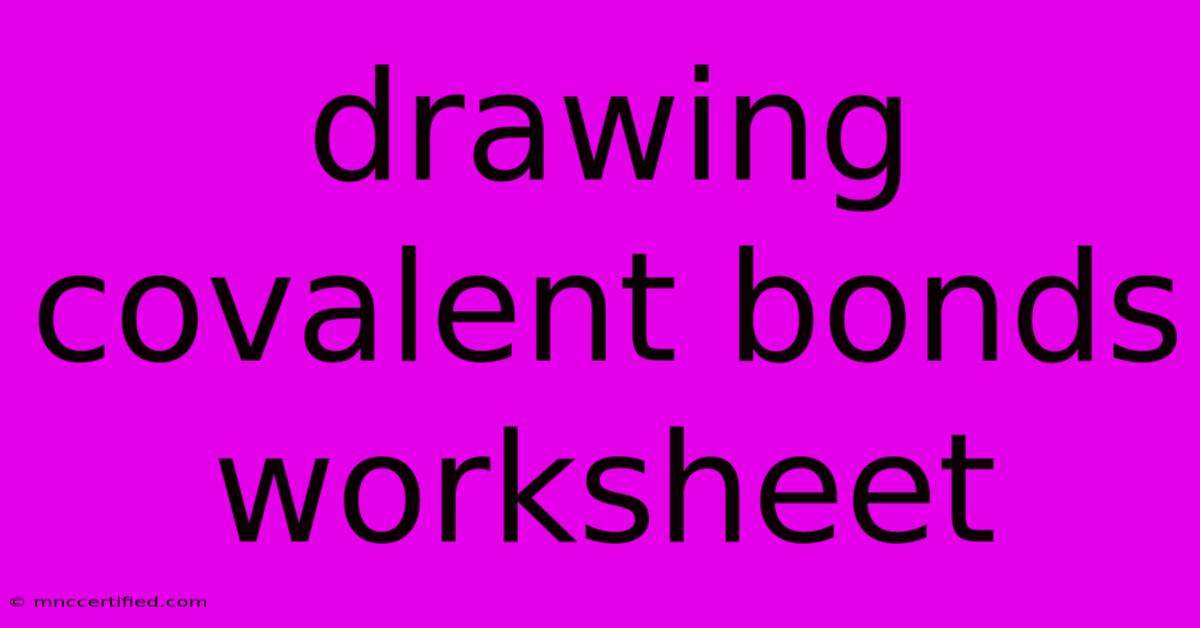Drawing Covalent Bonds Worksheet

Table of Contents
Mastering Covalent Bonds: A Comprehensive Worksheet Guide
Are you struggling to grasp the concept of covalent bonds? Do worksheets on this topic leave you feeling confused? Don't worry, you're not alone! Many students find covalent bonding challenging, but with the right approach and resources, mastering this crucial chemistry concept becomes much easier. This article will guide you through understanding covalent bonds and how to tackle related worksheets effectively. We'll cover everything from the basics to advanced applications, ensuring you build a strong foundation.
Understanding Covalent Bonds: The Basics
A covalent bond is a chemical bond formed when two atoms share one or more pairs of electrons. This sharing allows each atom to achieve a more stable electron configuration, typically resembling a noble gas. Unlike ionic bonds, which involve the transfer of electrons, covalent bonds result from the mutual attraction between atoms and their shared electrons.
Key Characteristics of Covalent Bonds:
- Shared electrons: Electrons are not transferred but are shared between atoms.
- Nonmetals: Covalent bonds typically occur between nonmetal atoms.
- Molecular compounds: Covalent bonds form molecular compounds rather than ionic crystals.
- Lower melting and boiling points: Covalent compounds generally have lower melting and boiling points compared to ionic compounds.
- Poor electrical conductivity: Covalent compounds usually do not conduct electricity in solid or liquid states.
Types of Covalent Bonds:
Covalent bonds aren't all created equal. The number of shared electron pairs determines the bond order and influences the properties of the molecule.
- Single covalent bond: One shared electron pair (e.g., H₂).
- Double covalent bond: Two shared electron pairs (e.g., O₂).
- Triple covalent bond: Three shared electron pairs (e.g., N₂).
Understanding these different bond orders is crucial for accurately representing molecules and predicting their properties.
Tackling Covalent Bonds Worksheets: A Step-by-Step Guide
Covalent bonding worksheets often require you to:
- Draw Lewis Dot Structures: This involves representing valence electrons as dots around the atomic symbol. This is the foundation for visualizing shared electron pairs.
- Identify the number of shared electron pairs: Count the number of shared electron pairs to determine the bond order (single, double, or triple).
- Predict molecular geometry: Based on the number of electron pairs (both bonding and lone pairs), predict the shape of the molecule using VSEPR theory (Valence Shell Electron Pair Repulsion).
- Determine polarity: Assess the electronegativity difference between atoms to determine if the bond is polar or nonpolar.
Common Challenges and How to Overcome Them
Many students find drawing Lewis structures and predicting molecular geometry challenging. Here are some tips:
- Practice regularly: The more you practice drawing Lewis structures, the easier it will become.
- Use helpful resources: There are many online resources, including videos and interactive simulations, that can help you visualize and understand covalent bonds.
- Break down complex molecules: If you're struggling with a large molecule, break it down into smaller, more manageable parts.
- Check your work: Always double-check your work to ensure you've correctly counted valence electrons and shared pairs.
Advanced Covalent Bonding Concepts:
Once you've mastered the basics, you can delve into more advanced concepts like:
- Resonance structures: Molecules with delocalized electrons.
- Coordinate covalent bonds: One atom provides both electrons in the shared pair.
- Polarity and intermolecular forces: How the polarity of covalent bonds influences the properties of molecules.
Finding More Resources and Practice Worksheets
Numerous online resources provide practice worksheets and interactive exercises on covalent bonds. Search for "covalent bonding worksheet pdf" or "covalent bonding practice problems" to find numerous options catering to different skill levels. Look for worksheets that incorporate a variety of molecule types and complexities to challenge yourself and reinforce your learning. Remember that consistent practice is key to mastering any scientific concept.
By following this guide and practicing regularly, you will confidently tackle any covalent bonds worksheet and strengthen your understanding of this fundamental chemistry concept. Remember that understanding the underlying principles, coupled with consistent practice, will pave the way for success. Good luck!

Thank you for visiting our website wich cover about Drawing Covalent Bonds Worksheet. We hope the information provided has been useful to you. Feel free to contact us if you have any questions or need further assistance. See you next time and dont miss to bookmark.
Featured Posts
-
Industrial Real Estate Investment
Nov 20, 2024
-
Advantage Gold Minimum Investment
Nov 20, 2024
-
Michael Hanson Fisher Investments
Nov 20, 2024
-
Is New Sapience A Good Investment
Nov 20, 2024
-
Trump Taps Linda Mc Mahon For Education
Nov 20, 2024